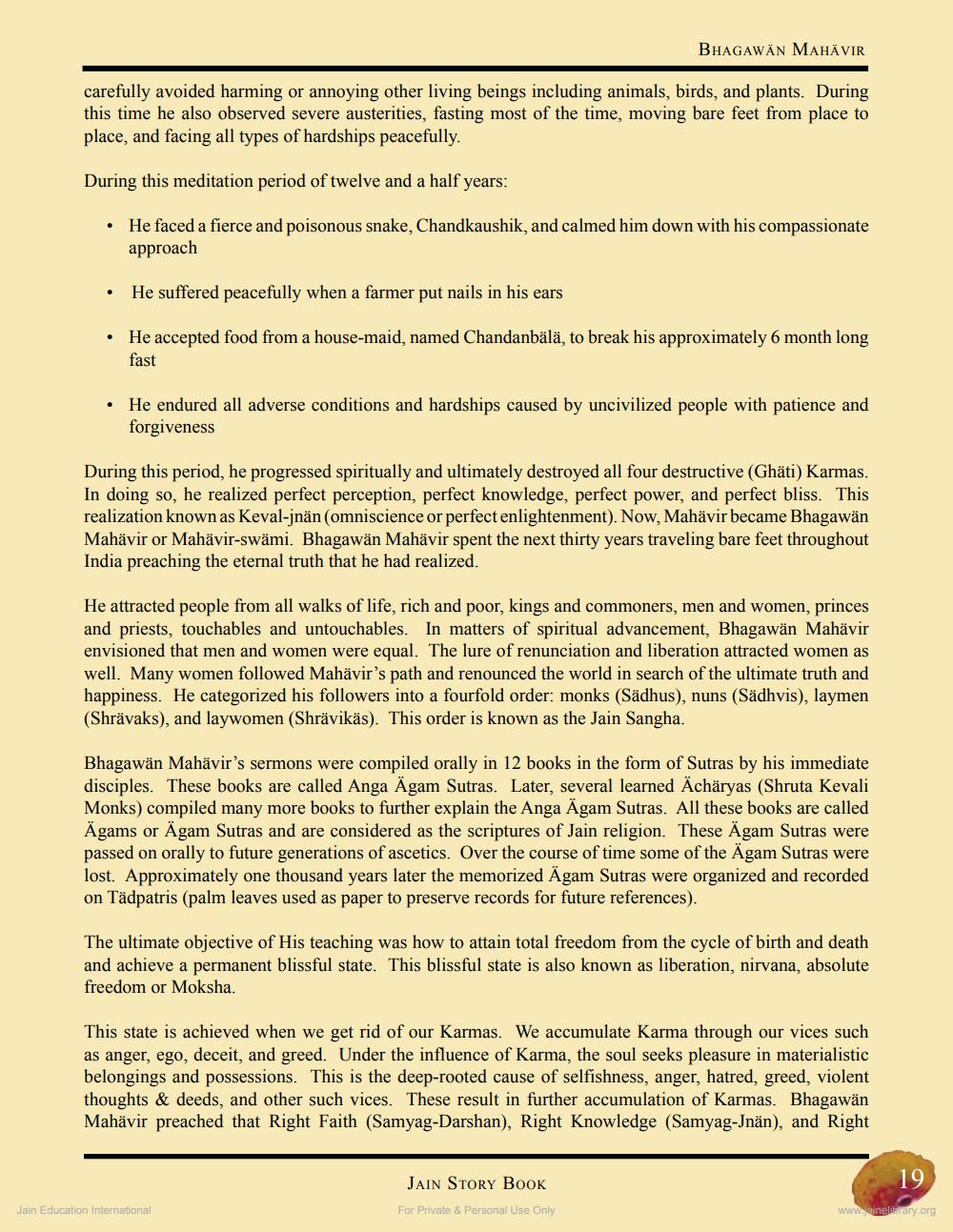Book Title: Bhagwan Mahavir Author(s): JAINA Education Committee Publisher: JAINA Education Committee View full book textPage 3
________________ BHAGAWAN MAHAVIR carefully avoided harming or annoying other living beings including animals, birds, and plants. During this time he also observed severe austerities, fasting most of the time, moving bare feet from place to place, and facing all types of hardships peacefully. During this meditation period of twelve and a half years: He faced a fierce and poisonous snake, Chandkaushik, and calmed him down with his compassionate approach . . He suffered peacefully when a farmer put nails in his ears He accepted food from a house-maid, named Chandanbālā, to break his approximately 6 month long fast He endured all adverse conditions and hardships caused by uncivilized people with patience and forgiveness During this period, he progressed spiritually and ultimately destroyed all four destructive (Ghati) Karmas. In doing so, he realized perfect perception, perfect knowledge, perfect power, and perfect bliss. This realization known as Keval-jnän (omniscience or perfect enlightenment). Now, Mahavir became Bhagawan Mahavir or Mahävir-swämi. Bhagawän Mahävir spent the next thirty years traveling bare feet throughout India preaching the eternal truth that he had realized. He attracted people from all walks of life, rich and poor, kings and commoners, men and women, princes and priests, touchables and untouchables. In matters of spiritual advancement, Bhagawan Mahavir envisioned that men and women were equal. The lure of renunciation and liberation attracted women as well. Many women followed Mahävir's path and renounced the world in search of the ultimate truth and happiness. He categorized his followers into a fourfold order: monks (Sädhus), nuns (Sädhvis), laymen (Shrävaks), and laywomen (Shrävikäs). This order is known as the Jain Sangha. Bhagawan Mahavir's sermons were compiled orally in 12 books in the form of Sutras by his immediate disciples. These books are called Anga Ägam Sutras. Later, several learned Acharyas (Shruta Kevali Monks) compiled many more books to further explain the Anga Ägam Sutras. All these books are called Ägams or Ägam Sutras and are considered as the scriptures of Jain religion. These Ägam Sutras were passed on orally to future generations of ascetics. Over the course of time some of the Ägam Sutras were lost. Approximately one thousand years later the memorized Agam Sutras were organized and recorded on Tädpatris (palm leaves used as paper to preserve records for future references). The ultimate objective of His teaching was how to attain total freedom from the cycle of birth and death and achieve a permanent blissful state. This blissful state is also known as liberation, nirvana, absolute freedom or Moksha. This state is achieved when we get rid of our Karmas. We accumulate Karma through our vices such as anger, ego, deceit, and greed. Under the influence of Karma, the soul seeks pleasure in materialistic belongings and possessions. This is the deep-rooted cause of selfishness, anger, hatred, greed, violent thoughts & deeds, and other such vices. These result in further accumulation of Karmas. Bhagawän Mahävir preached that Right Faith (Samyag-Darshan), Right Knowledge (Samyag-Jnän), and Right Jain Education International JAIN STORY Book For Private & Personal Use Only 19 www.ainelibrary.orgPage Navigation
1 2 3 4 5
